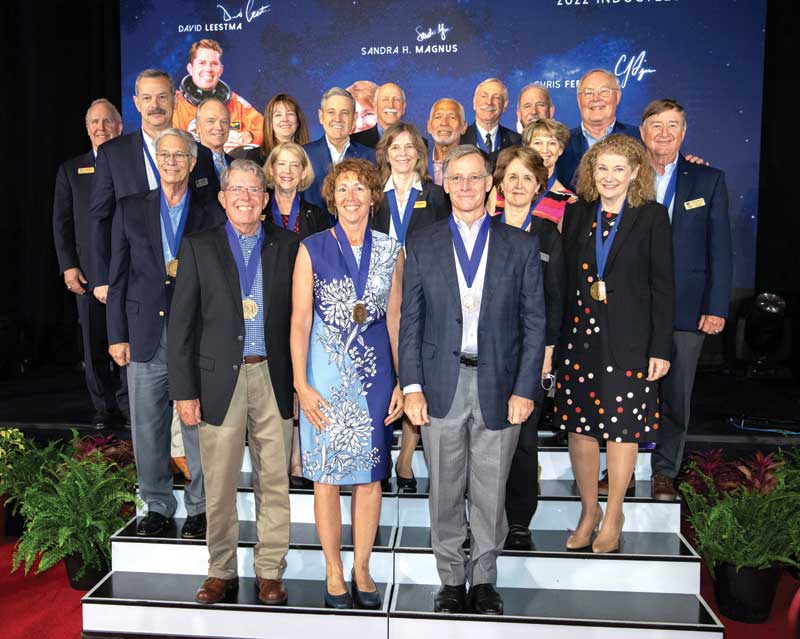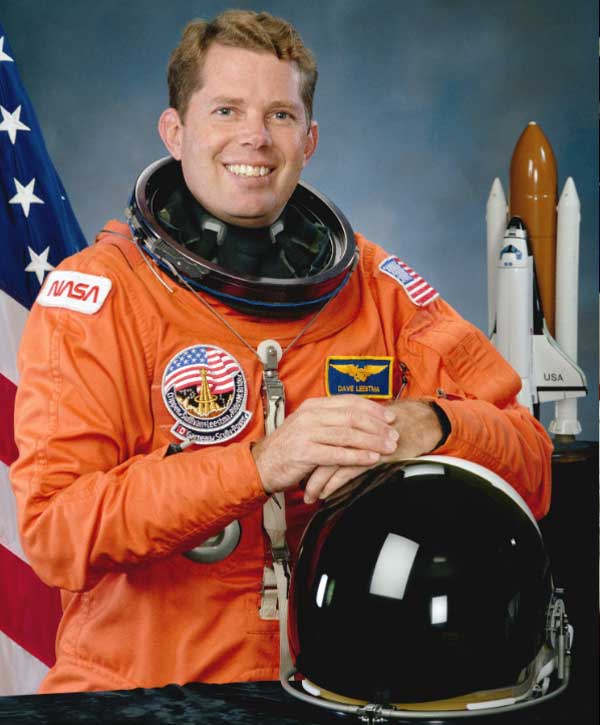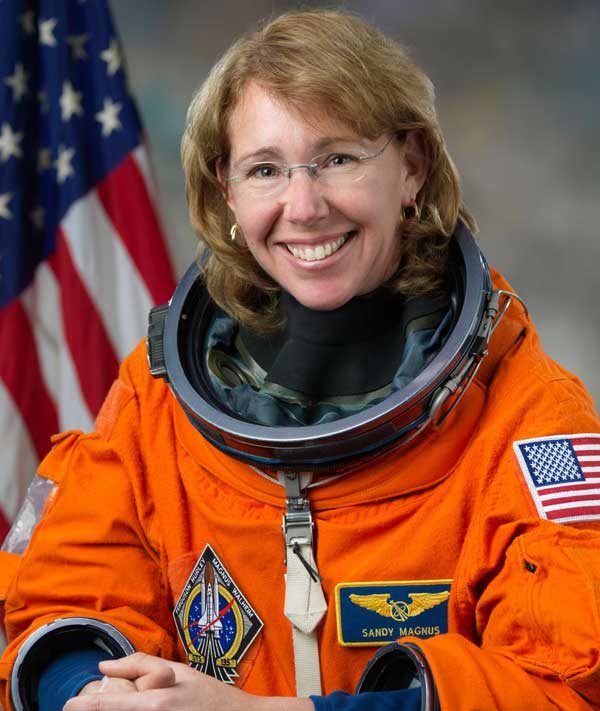Three Space Explorers Inducted into Astronaut Hall of Fame at NASA’s Kennedy Space Center Visitor Complex
By Linda Herridge, NASA's John F. Kennedy Space Center // June 23, 2022
Space Shuttle Atlantis served as backdrop for U.S. Astronaut Hall of Fame induction ceremony

BREVARD COUNTY • KENNEDY SPACE CENTER, FLORIDA – The Space Shuttle Atlantis attraction served as the backdrop for the U.S. Astronaut Hall of Fame induction ceremony June 11 at NASA’s Kennedy Space Center Visitor Complex in Florida. Beneath Atlantis, former astronauts Chris Ferguson, David Leestma, and Sandra Magnus were inducted as the class of 2022. This year’s induction brings the total number of AHOF members to 105.
Master of Ceremonies John Zarrella praised the inductees for demonstrating outstanding accomplishments in furthering NASA’s mission of exploration and discovery. Together, Ferguson, Leestma, and Magnus have a combined total of more than 200 days in space.
“Next month, Kennedy will celebrate its 60th anniversary, and with it, the six decades of innovation and exploration, and the off-world work that has improved life here on our planet, “ said Center Director Janet Petro. “Today, we honor three people who have had a part of building that legacy through their contributions to human spaceflight.”
During the ceremony, each of the inductees received an official medal and were inducted as members of the 21st class of astronauts.
NASA Associate Administrator Bob Cabana presented Chris Ferguson with his official medal. “I can’t think of anyone more deserving for induction into the Astronaut Hall of Fame, and I am deeply honored to be the one allowed to present this medal,” Cabana said.

Christopher J. Ferguson (Captain, U.S. Navy, Ret.)
“As I humbly stand here before you, I couldn’t imagine 40 years ago what possibilities lie ahead,” Ferguson said. “Thank you so very much.”
Christopher J. Ferguson was born in Philadelphia, Pennsylvania. He graduated from Drexel University in 1984 with a Bachelor of Science in mechanical engineering. He earned his master’s in aeronautical engineering in 1991 from the Naval Postgraduate School.
Ferguson was selected by NASA in 1998. Following initial training, he was assigned technical duties associated with the shuttle main engine, external tank, solid rocket boosters, and flight software. He also served as spacecraft communicator for the STS-118, 120, 128, and 129 missions. Ferguson served as pilot of STS-115 aboard Atlantis, and commanded STS-126 aboard Endeavour, and STS-135 aboard Atlantis, the final space shuttle mission.
The STS-115 mission successfully restarted assembly of the International Space Station. STS-126 was a night launch from Kennedy and returned to land at Edwards Air Force Base in California. The STS-135 mission delivered approximately 10,000 pounds of supplies and spare parts to the space station using the Raffaello Multi-Purpose Logistics Module. The crew also delivered the robotic refueling module and returned a failed ammonia pump to help NASA improve pump designs for the future.
Ferguson has accumulated 5,700 flight hours in more than 30 aircraft types. He logged more than 40 days in space. He retired from the Navy in June 2010 and from the NASA astronaut corps in December 2011. Ferguson most recently served as a commercial astronaut for The Boeing Company, and is now the operations manager for the company.

David C. Leestma (Captain, U.S. Navy, Ret.)
Hall of Famer Jerry Ross described David’s astronaut career and inducted him into the U.S. Astronaut Hall of Fame
“It’s exciting to fly in space. For all you scholars out there, don’t be afraid to question what you know,” Leestma said.
David C. Leestma was born in Muskegon, Michigan. He earned a Bachelor of Science in aeronautical engineering in 1971 from the U.S. Naval Academy and a Master of Science in aeronautical engineering in 1972 from the U.S. Naval Postgraduate School.
Leestma was selected by NASA to be an astronaut in 1980. Following his first flight, STS-41G aboard Challenger in October 1984, he served as Capsule Communicator for STS-51C through STS-61A. He then served as chief of the Mission Development Branch responsible for assessing the operational integration requirements of payloads that would fly aboard the space shuttle.
His other missions included STS-28 aboard Columbia and STS-45 aboard Atlantis. During the STS-41G mission, the crew deployed the ERBS satellite using the remote manipulator system and conducted numerous in-cabin experiments, as well as activating eight “Getaway Special” canisters. Leestma and crewmate Kathryn Sullivan successfully conducted a three-and-a-half-hour spacewalk to demonstrate the feasibility of actual satellite refueling.
During STS-28, the mission carried Department of Defense payloads. After 80 Earth orbits, the five-day mission concluded with a lakebed landing at Edwards Air Force Base in California. During the nine-day mission of STS-45, the crew operated 12 experiments of the ATLAS-1 (Atmospheric Laboratory for Applications and Science) cargo. After completing 142 Earth orbits, STS-45 landed at Kennedy’s Shuttle Landing Facility.
Leestma has logged more than 3,500 hours of flight time, including nearly 1,500 hours in the F-14A. He logged a total of 532.7 hours (about 22 days) in space. He retired from the NASA astronaut corps in 2014 and remains in the Houston area.

Sandra H. Magnus
Hall of Famer Susan Helms inducted Sandra into the U.S. Astronaut Hall of Fame.
“I’m truly honored to be standing here today to be inducted into the Astronaut Hall of Fame,” Magnus said. “From a young age, I knew I wanted to be an astronaut. The first women selected to be astronauts showed me my path.”
Sandra H. Magnus was born in Belleville, Illinois. She received a bachelor’s degree in physics and a master’s degree in electrical engineering from the University of Missouri-Rolla in 1986 and 1990, respectively, and a doctorate in 1996 from the School of Material Science and Engineering at the Georgia Institute of Technology.
Magnus was selected by NASA in April 1996 and reported to the Johnson Space Center in August 1996. After two years of training and evaluation, she was qualified for flight assignment as a mission specialist. She worked in the Astronaut Office Payloads/Habitability Branch for two years and worked with the European Space Agency, National Space Development Agency of Japan, and Brazil on science freezers, glove boxes, and other facility-type payloads. She traveled to Russia in support of hardware testing and operational products development.
Her spaceflight experience includes STS-112 aboard Atlantis in October 2002, STS-126 aboard Endeavour in November 2008, and STS-135, the final shuttle launch, aboard Atlantis in July 2011. STS-112 delivered the S-1 truss structure to the International Space Station. Magnus operated the station’s robotic arm during three spacewalks required to outfit and activate the new component.
During STS-126, another mission to the space station, Magnus transferred to the station and served as Flight Engineer 2 and science officer on Expedition 18. She returned to Earth aboard STS-119 in March 2009. During STS-135, Magnus was assigned loadmaster and was responsible for the transfer of nearly 10,000 pounds of supplies to the station and 6,000 pounds of equipment for return. She helped install the Multi-Purpose Logistics Module on the station and supported the spacewalk.
She became deputy chief of the Astronaut Office at Johnson Space Center in September 2012. Magnus left the NASA astronaut corps in October 2012, after being appointed executive director of the American Institute of Aeronautics and Astronautics. Magnus logged more than 150 days in space.
“Today, we recognize their achievements and celebrate their contributions to our agency, our country, and our planet. Congratulations to the inductees,” Petro said.
The 2022 inductees were selected by a committee of Hall of Fame astronauts, former NASA officials, flight directors, historians, and journalists. The process is administered by the Astronaut Scholarship Foundation (ASF), which was founded by the original seven Mercury astronauts in 1984.
To be eligible, an astronaut must have made his or her first flight at least 17 years before the induction and have been retired from NASA astronaut corps. for at least five years. Each candidate must be a U.S. citizen and a NASA-trained commander, pilot, or mission specialist who has orbited Earth at least once.
The ASF has awarded more than $7 million to more than 700 of the nation’s top scholars majoring in science, technology, engineering, and mathematics, or STEM, studies.













